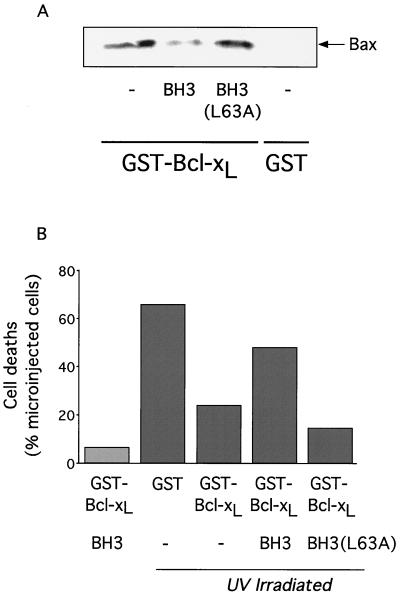FIG. 3.
Inhibition of Bcl-xL antiapoptotic function by Bax-BH3 peptide. (A) Bax-BH3 peptide inhibits interaction between GST-Bcl-xL and Bax in vitro. Rat-1/c-MycERTAM fibroblasts grown in 10% FCS in the absence of OHT were lysed as described in Materials and Methods. Cell lysates were incubated with glutathione Sepharose beads prebound with either GST or GST-Bcl-xL(ΔTM) in the presence or absence of 200 μM Bax-BH3 peptide or Bax-BH3L63A mutant peptide as indicated. Glutathione Sepharose beads were then washed, bound polypeptides were eluted with SDS sample buffer and fractionated by SDS-PAGE, and the presence of endogenous Bax was assessed by immunoblotting with anti-Bax antibody. (B) Bax-BH3 peptide inhibits the antiapoptotic action of Bcl-xL in intact cells. Either GST (0.2 mg/ml) or GST-Bcl-xL(ΔTM) (0.2 mg/ml) in PBS were mixed with the fluorescent microinjection marker Oregon Green dextran (0.5%, wt/vol) in the presence or absence of either Bax-BH3 peptide (0.2 mg/ml) or Bax-BH3L63A mutant peptide (0.2 mg/ml) and then microinjected into Rat-1/c-MycERTAM fibroblasts grown in 10% FCS in the absence of OHT. Thirty minutes following microinjection, cells were washed once in PBS and subjected to 25 mJ of UV irradiation (Stratalinker UV cross-linker; Stratagene, La Jolla, Calif.) in the absence of medium, followed by incubation at 37°C for 6 h in normal growth medium. The viability of microinjected cells was then assessed by fluorescence microscopy as described in Materials and Methods. The data presented are from one experiment that is representative of four independent experiments. Each experiment comprised five observations; GST, GST-Bcl-xL, GST-Bcl-xL/Bax-BH3, and GST-Bcl-xL/Bax-BH3L63A solutions were injected within distinct areas of the same cell population seeded on glass coverslips 24 h prior to UV treatment. The same microcapillary loaded with GST-Bcl-xL/Bax-BH3 was used to microinject the cell population that was not treated with UV.

